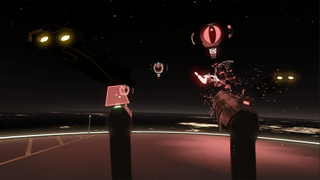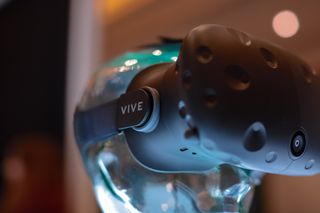Space Pirate Trainer nails the purity of an arcade FPS in VR

Imagine if Space Invaders was immersive. Genuinely immersive. You feel like you’re that lone, besieged tank, relentless waves of alien ships descending from above. They’re menacing in their calmness as they fire down upon you. You hear their shots chip away at the only meager cover you have left. You pause with satisfaction to watch the alien ships explode each time you land a killing shot. Your death is inevitable. The only question is how long you can delay it.
That’s more or less the idea developer I-Illusions started with as it prototyped VR shooter Space Pirate Trainer.
“We really want to have that arcade feeling,” developer Dirk Van Welden told me at Valve’s recent Vive VR developer showcase. “That’s important for us. We really enjoy the early Space Invaders, Galaga type of games. We want the look to be a bit of a Blade Runner look. We also want a pick up and play experience.”

I saw 11 other VR games coming to the Vive at Valve's recent event. Read about all of them here.
Van Welden said that when he first started working with VR, he thought about what he’d really want to do with a pair of controllers, and the answer was clear: shoot laser guns. “So I thought about what the perfect first person shooter experience would be like in VR,” he said. “The guns I’ve tried to make feel just right. I started playing with bullet time and dodging. Making the bullet fly at the right speed, making time slow down at the right pace, that’s really important. You have to do a lot of iteration and testing to get it just right. If you’ve got the base of that, then you can start doing extra mechanics with the guns.”
Space Pirate Trainer may have been the simplest demo I played at Valve’s developer showcase, but it was also my favorite. The rapid fire laser guns made me feel in control as waves of drones swirled around me, and the bullet time when they fired gave me just enough time to dodge—and feel cool—without interrupting the flow of the game or making it too easy. There wasn’t much complexity or variety here. Each wave brought on a few more drones, some of which took two hits to kill instead of one, and they attacked in varying patterns each wave. But like any good arcade game, I already felt the pull in Space Pirate Trainer to keep playing and reaching for a higher score.

Reaching over my shoulder let me swap either laser pistol for a shield, which can block shot from the drones and emit a knockback pulse to buy some breathing room. There’s already a fun risk reward mechanic at play with the gun and shield: am I a good enough shot with two pistols to take out the drones before they land three hits on me (that’s a game over), or should I take the more measured gun + shield approach?
I liked opening a round with both guns blazing, then quickly pulling out a shield when I heard the telltale charging sound of a drone about to fire. Another option I didn’t spend much time with was the laser pistol’s railgun firing mode, which fires off a single deadly shot after a short charge-up time. Landing that shot feels great, but the drones are small and always on the move, which makes autofire an easier weapon for the beginner. Railgun in one hand, autofire in the other, though? Now we’re cookin’ with lasers.
PC Gamer Newsletter
Sign up to get the best content of the week, and great gaming deals, as picked by the editors.
Van Welden has a lot of ideas for adding to Space Pirate Trainer, which does feel like more of a demo than a full game, even with its arcade roots. “The gun modes are too similar, so we’ll be changing the color and strength of certain laser bullets,” he said. “The railgun is a good example, because that’s totally different. Maybe spreadhsots and stuff. You have a shield that can do a pulse, but you could have grenades and gravity pulse. You could do a lot of stuff like that. Even placing a turret or something. We’re still thinking about that as well. But that might not work in VR. We really have to playtest everything to make it feel right.”
Also on the table: boss battles, which could require shooting weak spots or some light puzzle solving. He suggested upgrading weapons may follow a roguelike approach, and cited Vlambeer’s Nuclear Throne as a recent inspiration. “Every wave you can select some kind of upgrade, there’s an upgrade tree,” he suggests. “You could have a lot of different strategies to upgrade yourself. The shield could be an upgrade. The shield pulse could be another upgrade. If you have those, and waves that aren’t always the exact same but are procedurally the same, you could have a very good game that’s always pick up and play.”
I-Illusions hopes to have a game ready to go by the time the Vive launches, or at least in 2016. Getting Space Pirate Trainer to the developer showcase was a mad rush—they’d stopped working on the prototype in favor of another back in December, and got a message from Valve just 12 days before the event. But clearly they nailed the fundamentals; I just hope they take the time needed to build a full game around that base.

Wes has been covering games and hardware for more than 10 years, first at tech sites like The Wirecutter and Tested before joining the PC Gamer team in 2014. Wes plays a little bit of everything, but he'll always jump at the chance to cover emulation and Japanese games.
When he's not obsessively optimizing and re-optimizing a tangle of conveyor belts in Satisfactory (it's really becoming a problem), he's probably playing a 20-year-old Final Fantasy or some opaque ASCII roguelike. With a focus on writing and editing features, he seeks out personal stories and in-depth histories from the corners of PC gaming and its niche communities. 50% pizza by volume (deep dish, to be specific).
Most Popular



